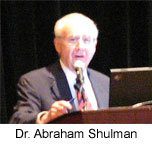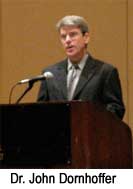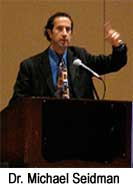Notes from the 27th International Tinnitus Forum – 2009
By Barry Keate
Barry Keate, has lived with tinnitus over 40 years and has published 150+ research articles on numerous aspects of tinnitus. He is an expert on the condition and a well-known advocate for those with tinnitus.
The 27th International Tinnitus Forum was held at the Marriott San Diego Hotel and Marina, October 3rd, 2009, in San Diego, California. Sponsored by the Martha Entenmann Tinnitus Center, physicians and researchers from around the world met to share their latest findings and advancements in tinnitus, made in various fields.
As in recent years, many of the presentations focused on basic research and brain imaging techniques. I will minimize much of this as it takes a highly skilled researcher to make sense of it. However there was much discussed on various therapies that are in development that should be interesting to many people suffering from tinnitus.
Abraham Shulman, MD
Martha Entenmann Tinnitus Center, Brooklyn, NY
 Dr. Shulman presented further findings supporting his theory of the final common pathway for tinnitus through the brain. He made extensive use of brain imaging using quantitative electroencephalography (QEEG). This method records the electrical activity on the scalp resulting from the firing of neurons in the brain.
Dr. Shulman presented further findings supporting his theory of the final common pathway for tinnitus through the brain. He made extensive use of brain imaging using quantitative electroencephalography (QEEG). This method records the electrical activity on the scalp resulting from the firing of neurons in the brain.
He has hypothesized that the final common pathway is related to gamma amino butyric acid (GABA) receptors in the brain. GABA is a calming neurotransmitter and inhibits central nervous system synapse activity. Impairment of GABA activity is linked to epilepsy and other neurologic conditions, supporting the theory that tinnitus is an epileptic-like condition occurring in the auditory cortex.
The results of Dr. Shulman’s earlier work on tinnitus and the brain is located in our Tinnitus Library
One of the reasons Arches Tinnitus Relief Formula (TRF) is helpful for tinnitus is that Ginkgo biloba extract, especially the bilobalide component, acts as a GABA enhancer. The bilobalide component of the ginkgo used in Arches TRF is specified to be at least 3.4% or more. This is approximately double the amount found in other “quality” ginkgo formulations. Additionally, we have increased the industry standardized 24/6 extract to 25/8.9.
View our Ginkgo Certificate of Analysis.
Tobias Kleinjung, MD, University of Regensburg
Regensburg, Germany
 Dr. Kleinjung presented strategies for developing Transcranial Magnetic Stimulation (TMS) into a tinnitus treatment therapy. TMS has been in development for 25 years for other uses. It introduces electrical stimulation in the brain using powerful magnetic stimulation outside the skull. While it holds great promise for reducing tinnitus in the future, currently the stimulation cannot penetrate deep enough to affect the auditory cortex.
Dr. Kleinjung presented strategies for developing Transcranial Magnetic Stimulation (TMS) into a tinnitus treatment therapy. TMS has been in development for 25 years for other uses. It introduces electrical stimulation in the brain using powerful magnetic stimulation outside the skull. While it holds great promise for reducing tinnitus in the future, currently the stimulation cannot penetrate deep enough to affect the auditory cortex.
Repetitive TMS (rTMS) may produce lasting results by interrupting errant electrical signals. Experiments in different frequencies, duration of stimulation and electrode coil design are all involved in trying to reach the optimum penetration and results.
Most studies lead to significant reduction in tinnitus perception for a short period of time. A few studies have experienced results lasting for up to six months. According to Dr. Kleinjung, it is very difficult to create a viable placebo treatment in order to compare results. “Real” rTMS produces sound and a tingling sensation on the skin. Patients can tell when placebo treatment is given due to lack of skin reaction. This can lead to unreliable data and skewed results.
John Dornhoffer, MD, University of Arkansas, Little Rock, AK
 Dr. Dornhoffer presented on the theory and practical applications of TMS. Degeneration of inner ear hair cells leads to depolarization of structures in the auditory cortex that processes sound. This, in turn, leads to over excitation of neurons. TMS can reduce the cortical depolarization and excitation.
Dr. Dornhoffer presented on the theory and practical applications of TMS. Degeneration of inner ear hair cells leads to depolarization of structures in the auditory cortex that processes sound. This, in turn, leads to over excitation of neurons. TMS can reduce the cortical depolarization and excitation.
There are two electrical approaches to reducing depolarization. One is through surgical implantation of electronic devices such as a cochlear implant and electronic arrays implanted in the brain. The other method is TMS using magnetic force to penetrate the skull, inducing electrical activity that affects the brain.
Low frequency and high frequency TMS have different effects. Intensity of the magnetic force can be increased at the motor cortex area of the brain until it results in thumb twitches. This is called the threshold level, where involuntary motor responses begin to occur. The number of pulses and duration of treatment in rTMS have yet to be determined.
Coil design, that transmits the magnetic force, is still being worked on. Currently, TMS can only penetrate 2 cm into the brain. The auditory cortex lies at least 5 cm down. Areas in the brain deeper than 2 cm can be affected but only indirectly.
Most studies show an improvement in tinnitus of 20-80%. However, the difficulty of producing a reliable placebo treatment may be influencing data. Dr. Dornhoffer believes the placebo effect may be responsible for 40% of patient’s success.
Neuronavigation is used to locate the most likely areas of the brain to target. This varies by the patient and still needs a lot of work to refine it.
Dr. Dornhoffer conducted a TMS study on thirteen patients using a placebo that he believed to be effective. It was a crossover type study: two weeks of real or placebo treatment, then all patients were changed to the opposite treatment. He had successful results in about half the patients. Questions also arise about what type of patient is more likely to benefit and why do the rest not benefit? These questions are yet to be unanswered.
Three of his patients benefited bilaterally, when the effect was felt on the same side as the coil. However, more patients benefited contralaterally, when the greatest effect occurred on the opposite side of the brain from the TMS coil.
People who respond favorably to TMS are placed in maintenance programs. One patient had a significant reduction after the first treatment. Ten days later he complained that tinnitus had returned. A second treatment lasted for two weeks. After the third treatment, the patient had reduced sound for four months.
About 25% of people have results that last longer than a few weeks. Most positive responders return for further treatment within a few days to a couple of weeks. Since treatment is very expensive, researchers have a long way to go before TMS becomes a clinical treatment.
Michael Seidman, MD, Henry Ford Health System, Detroit, MI
 Dr. Seidman presented his findings on Magnetoencephalography (MEG) research and tinnitus. MEG measures magnetic emissions from the brain.
Dr. Seidman presented his findings on Magnetoencephalography (MEG) research and tinnitus. MEG measures magnetic emissions from the brain.
MEG allows researchers to have a more pinpointed image of the brain over other imaging techniques. It takes place in a noise-free environment, as opposed to MRI, which are very noisy, requiring ear plugs. It is completely non-invasive and does not require the use of injected dyes as some other imaging devices. According to Dr. Seidman there are only 6 MEG units available worldwide that can measure magnetic generation.
The objective in using MEG is to identify areas of the cortex and limbic system associated with tinnitus. It is another method of isolating the areas central to the creation and perception of tinnitus.
Dr. Seidman has studied 17 patients with MEG imaging. One patient had unilateral tinnitus in his right ear. When sound was introduced in the left ear, it showed up in the expected location, in the right auditory cortex. But, when sound was introduced in the right ear, it showed up in an area where it didn’t belong and was very weak. There is some kind of electrical interference in the affected ear that is not understood.
MEG imaging can determine what areas of the brain are coherent with each other. There are different areas of the brain that are firing at the same rate. It can be considered as cross-talk. When tinnitus exists on the right side, the left auditory cortex is active and if on the left side the opposite it true. This has great implications for those working with rTMS and surgical electrode implantation. It can greatly improve neuronavigation, which is used for locating the correct areas of the brain for electrical stimulation.
A previous article on Dr. Seidman and direct stimulation of the brain in located in our Tinnitus Library.
William Luxford, MD, House Ear Institute, Los Angeles, CA
Dr. Luxford discussed Neuromonics treatment and the House Ear Institute experience with it. The House Ear Institute has been using the Neuromonics device for the past few years. Neuromonics combines the sound of a masking-level noise with music.
The institute has had 47 patients. They were divided into three groups of patients; those who have completed the study, those who are in an active study and a group that did not like the device and felt it was not helping, did not complete the study. Two of the drop-out patients felt the device worsened their tinnitus.
The Neuromonics device costs $3500.00. Because this is a study, the researchers did not charge for their time. When it becomes available as a clinical tool, treatment is likely to add another $1500.00.
The completed study group began with two month fine-tuning of the device and becoming accustomed to it. They then went into a four month active study phase and transitioned into a maintenance phase.
According to Dr. Luxford, the patients who completed the study experienced greater than 60% improvement. The patients in the active group showed a result of 40% improvement. Those who dropped out did not feel the device worked and returned it for a refund. While he stated that the overall success rate was 67%, Dr. Luxford stated the study was conducted without a placebo group. They did not yet have results for the maintenance phase and were unsure how long the treatment will last or how effective maintenance will be.
The next meeting of the International Tinnitus Forum will be in September, 2010 in Boston, MA.
